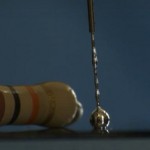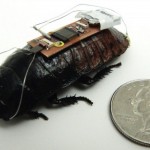Tag Archives: North Carolina State University
Liquid Metals Give 3D Printing a Twist
Cyborg Roaches Connected to Xbox Kinect Run on Autopilot
NC State nanoflowers can boost battery and solar cell capacity, make great prom accessories
We see a lot of sleek-looking technology pass through our doors, but it's rare that the inventions could be called beautiful by those who aren't immersed in the gadget world. We'd venture that North Carolina State University might have crossed the divide by creating an energy storage technology that's both practical and genuinely pretty. Its technology vaporizes germanium sulfide and cools it into 20-30 nanometer layers that, as they're combined, turn into nanoflowers: elegant structures that might look like the carnation on a prom dress or tuxedo, but are really energy storage cells with much more capacity than traditional cells occupying the same area. The floral patterns could lead to longer-lived supercapacitors and lithium-ion batteries, and the germanium sulfide is both cheap and clean enough that it could lead to very efficient solar cells that are more environmentally responsible. As always, there's no definite timetable for when (and if) NC State's technology might be commercialized -- so call someone's bluff if they promise you a nanoflower bouquet.
Filed under: Science
NC State nanoflowers can boost battery and solar cell capacity, make great prom accessories originally appeared on Engadget on Thu, 11 Oct 2012 20:37:00 EDT. Please see our terms for use of feeds.
Permalink North Carolina State University |
North Carolina State University |  ACS Publications | Email this | Comments
ACS Publications | Email this | Comments Scientists Creating Remote-Controlled Zombie Cockroaches
If taking over a cockroach’s nervous system sounds like your idea of a good time, you should join up with these North Carolina State University researchers, who are having a grand old time perverting nature and ushering in humanities downfall.

These researchers are molding a commercially-available chip that could be mounted on a cockroach, along with a wireless receiver, transmitter, and controller. It sounds crazy, but when you think about it, cockroaches can get into all kinds of small places that people can’t go. Heck they can even survive a nuclear blast, or so I’ve heard. In short, they are perfect for this job. By job, I mean becoming zombies and being controlled like an R/C car, or following along a pre-determined path like in the video clip below:
They are perfect for spy missions, or as explosive carriers and anything else that our minds can dream up. All the more reason to get the Raid out and step on these suckers.
[via Geek via Geeky-Gadgets]
Alt-week 9.8.12: Moon farming, self powered health monitors and bringing a 50,000 year-old girl to life
Alt-week peels back the covers on some of the more curious sci-tech stories from the last seven days.
Some weeks things get a little science heavy, sometimes it's a little on their weird side, and there's usually a bit of space travel involved, but these week's trend seems to be "mind-blowing." Want to grow carrots on the Moon? We got you covered. How about bringing a 50,000 year-old ancient human back to life? Sure, no biggie. Oh but what about a solar eruption that reaches some half a million miles in height. We've got the video. No, really we have. Mind blown? This is alt-week.
Filed under: Misc, Science, Alt
Alt-week 9.8.12: Moon farming, self powered health monitors and bringing a 50,000 year-old girl to life originally appeared on Engadget on Sat, 08 Sep 2012 17:30:00 EDT. Please see our terms for use of feeds.
Permalink NPR | | Email this | Comments
NPR | | Email this | Comments Researchers take full control of cockroach’s movement, turn it into a wireless sensor
Built-in power supply? Check. Ability to survive anything? Check. Easy to control? Okay, anyone who's had a cockroach as an uninvited houseguest knows that's not the case. So, rather than re-inventing the biological wheel with a robotic version, North Carolina State university researchers have figured out a way to remotely control a real Madagascar hissing cockroach. They used an off-the-shelf microcontroller to tap in to the roach's antennae and abdomen, then sent commands that fooled the insect into thinking danger was near, or that an object was blocking it. That let the scientists wirelessly prod the insect into action, then guide it precisely along a curved path, as shown in the video below the break. The addition of a sensor could allow the insects to one day perform tasks, liking searching for trapped disaster victims -- something to think about the next time you put a shoe to one.
Researchers take full control of cockroach's movement, turn it into a wireless sensor originally appeared on Engadget on Thu, 06 Sep 2012 11:21:00 EDT. Please see our terms for use of feeds.
Permalink | North Carolina State University | Email this | Comments
North Carolina State University | Email this | Comments Researchers propose à la carte internet services, overhaul for web infrastructure
A quintet of researchers funded by the National Science Foundation have envisioned a new internet architecture, one where features could be purchased à la carte. The proposed framework would allow users to fine tune their experience by choosing from a variety of connection services. Let's say, for example, that a customer's connection is fine for browsing the web, but it doesn't pass muster for streaming content -- a service dedicated to video delivery could be added to close the gap. "Ultimately, this should make the internet more flexible and efficient, and will drive innovation among service providers to cater to user needs," report co-author Rudra Dutta told The Abstract. A piecemeal next-gen web is no easy feat, however, as it would require revamping the web's infrastructure with new protocols for choosing particular features, completing payments and monitoring network performance. The group's rough blueprint will be presented at a conference next week, but you can thumb through their short paper at the source.
Filed under: Internet
Researchers propose à la carte internet services, overhaul for web infrastructure originally appeared on Engadget on Sat, 11 Aug 2012 07:11:00 EDT. Please see our terms for use of feeds.
Permalink The Abstract, North Carolina State University |
The Abstract, North Carolina State University |  SIGCOMM (PDF) | Email this | Comments
SIGCOMM (PDF) | Email this | Comments NC State’s new efficient pico projector raises hopes for smartphone cinema
A team at North Carolina State University has developed a new liquid crystal projector that could spell the end of bulky and noisy cinema gear. Conventional tech passes unpolarized light through a filter, but the process is so inefficient that nearly 50 percent of the energy is wasted just keeping things cool. Fortunately, the Wolfpack and ImagineOptix filter claims to be 90 percent efficient -- meaning that future projectors could be far sleeker. It's also a good sign for future smartphone pico projectors, although we're not sure how the owners of our local theater will feel when we start undercutting them with just a phone and a white wall.
Filed under: Cellphones, Home Entertainment
NC State's new efficient pico projector raises hopes for smartphone cinema originally appeared on Engadget on Tue, 17 Jul 2012 01:08:00 EDT. Please see our terms for use of feeds.
Permalink | NC State | Email this | Comments
NC State | Email this | Comments NCSU creates stretchable conductors from silver nanowires, lets gadgets go the extra inch
 As often as we've seen flexible electronics, there haven't been many examples that could stretch -- a definite problem for wearables as well as any gadget that could afford to take a pull or squeeze. North Carolina State University's Yong Zhu and Feng Xu may have covered this gap through a form of silver nanowire conductor that keeps the energy flowing, even if the wire is stretched as much as 50 percent beyond its original length. By coating the nanowires with a polymer that traps the silver when solid, the researchers create an elastic material that can crumple and let the nanowire take the strain without interruption. Although the stretchy conductor's nature as a research project could put any practical use years into the future, Zhu notes that it can take loads of abuse, making it a perfect fit for rugged mobile devices. It should also allow for robots with a gentler touch and a more natural look... although we'll admit we're skittish about the creepy androids likely to follow.
As often as we've seen flexible electronics, there haven't been many examples that could stretch -- a definite problem for wearables as well as any gadget that could afford to take a pull or squeeze. North Carolina State University's Yong Zhu and Feng Xu may have covered this gap through a form of silver nanowire conductor that keeps the energy flowing, even if the wire is stretched as much as 50 percent beyond its original length. By coating the nanowires with a polymer that traps the silver when solid, the researchers create an elastic material that can crumple and let the nanowire take the strain without interruption. Although the stretchy conductor's nature as a research project could put any practical use years into the future, Zhu notes that it can take loads of abuse, making it a perfect fit for rugged mobile devices. It should also allow for robots with a gentler touch and a more natural look... although we'll admit we're skittish about the creepy androids likely to follow.
Filed under: Robots, Wearables, Science
NCSU creates stretchable conductors from silver nanowires, lets gadgets go the extra inch originally appeared on Engadget on Mon, 16 Jul 2012 17:01:00 EDT. Please see our terms for use of feeds.
Permalink NCSU |
NCSU |  Advanced Materials (Wiley) | Email this | Comments
Advanced Materials (Wiley) | Email this | Comments  Plastic has been the material of choice for 3D printing for quite some time now, but things are about to …
Plastic has been the material of choice for 3D printing for quite some time now, but things are about to … Cockroaches may very well be the pets of the future, considering the interest some scientists have developed for them. Read …
Cockroaches may very well be the pets of the future, considering the interest some scientists have developed for them. Read …



